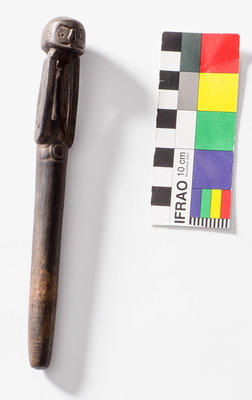Betelnut pestle
Production date
19th Century
Country
Papua New Guinea
State/Province
Milne Bay
See full details
Object detail
Description
Pestle: human face 180
Maker
Production date
19th Century
Production place
Measurements
L.178mm,W.23mm
History and use
Betelnut chewing is practised throughout Papua New Guinea as well as parts of Asia and East Africa. The ‘betel-nut’ actually comes from the seed of the areca palm, which is chewed along with the leaf of the betel plant, and mineral lime to produce a mildly narcotic effect.
In Papua New Guinea, the equipment associated with the preparation and consumption of betelnut is often highly decorated. In the Massim region, betelnut mortars and pestles can be miniature sculptures that carry a variety of designs including human forms, drums and canoes. This pestle is carved in shape of human head with arms reaching to its chin.
This example was collected in the late 19th Century by Sir William Macgregor, who served as Administrator of British New Guinea from 1887 to 1898. MacGregor later went on to become Governor of Queensland.
In Papua New Guinea, the equipment associated with the preparation and consumption of betelnut is often highly decorated. In the Massim region, betelnut mortars and pestles can be miniature sculptures that carry a variety of designs including human forms, drums and canoes. This pestle is carved in shape of human head with arms reaching to its chin.
This example was collected in the late 19th Century by Sir William Macgregor, who served as Administrator of British New Guinea from 1887 to 1898. MacGregor later went on to become Governor of Queensland.
Registration number
MAC1116



